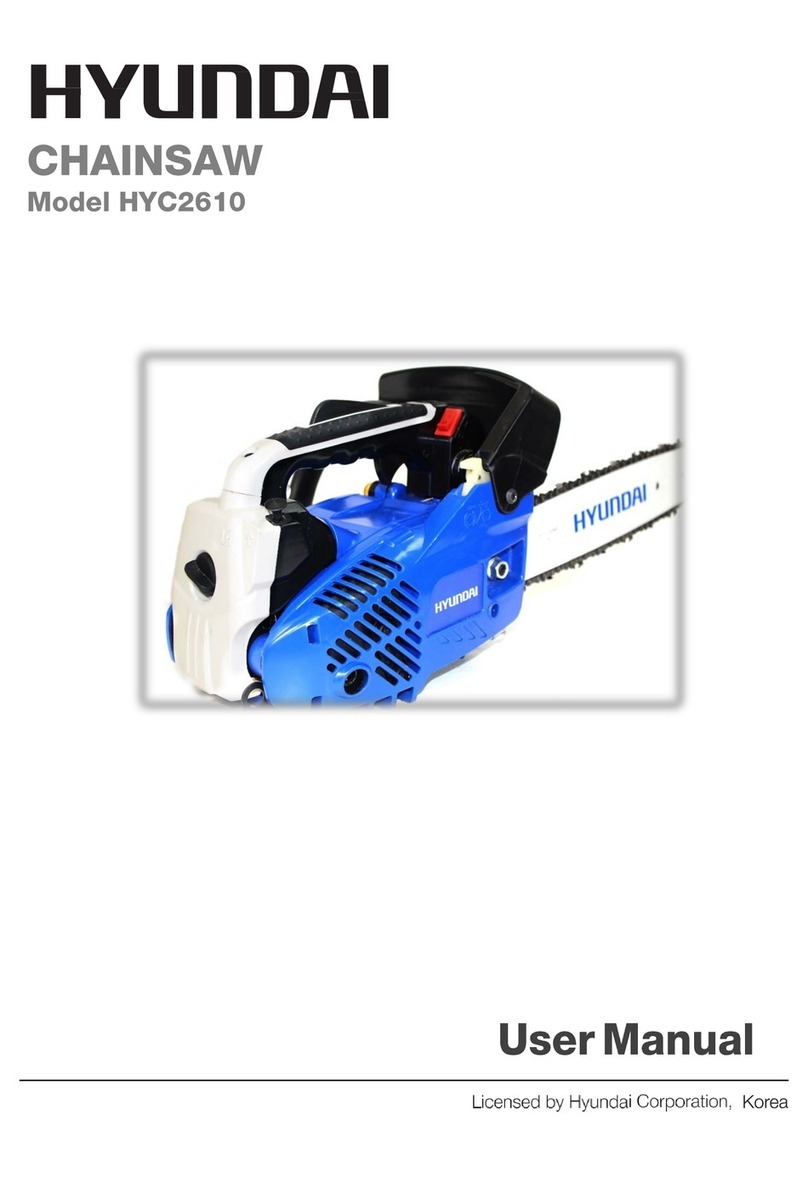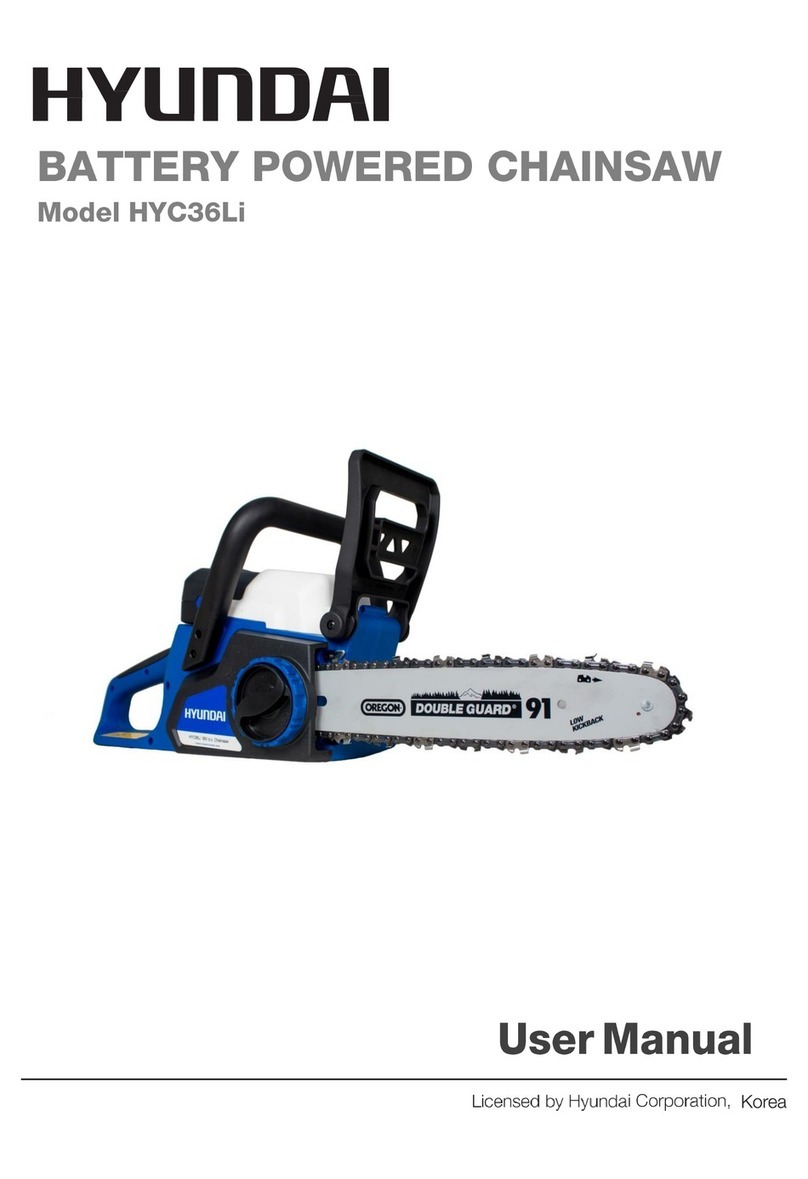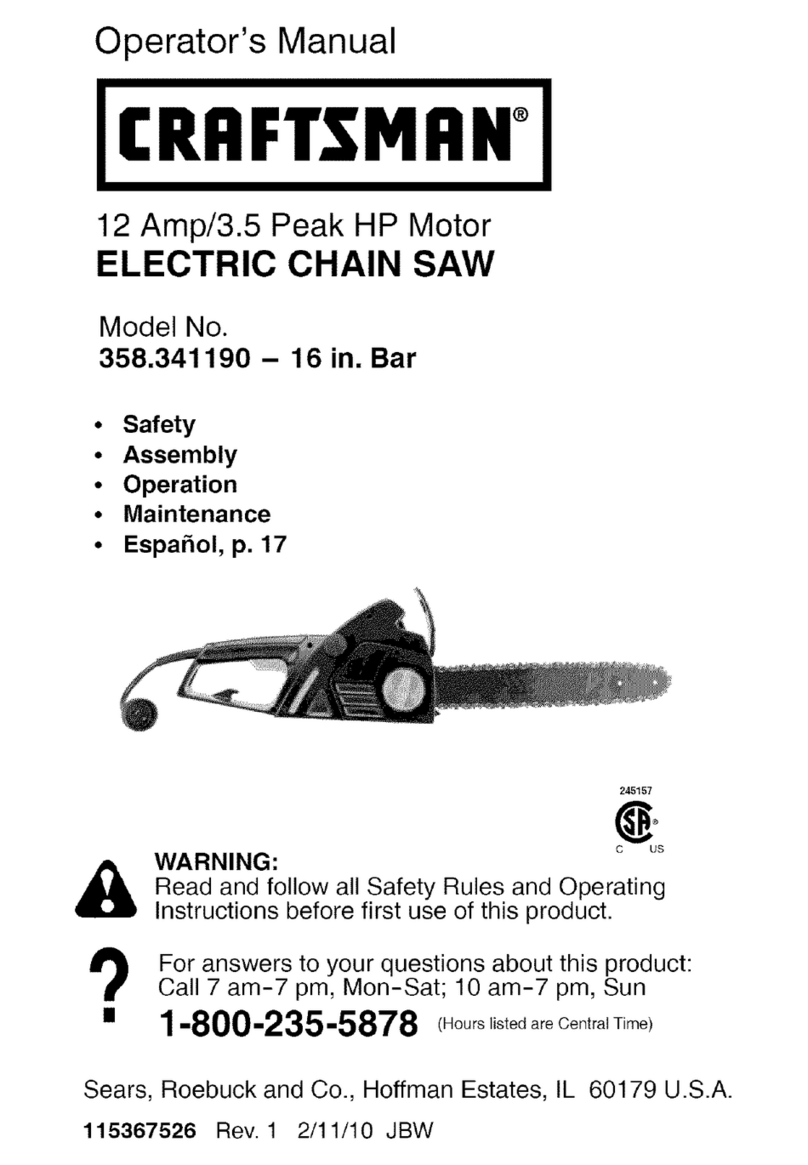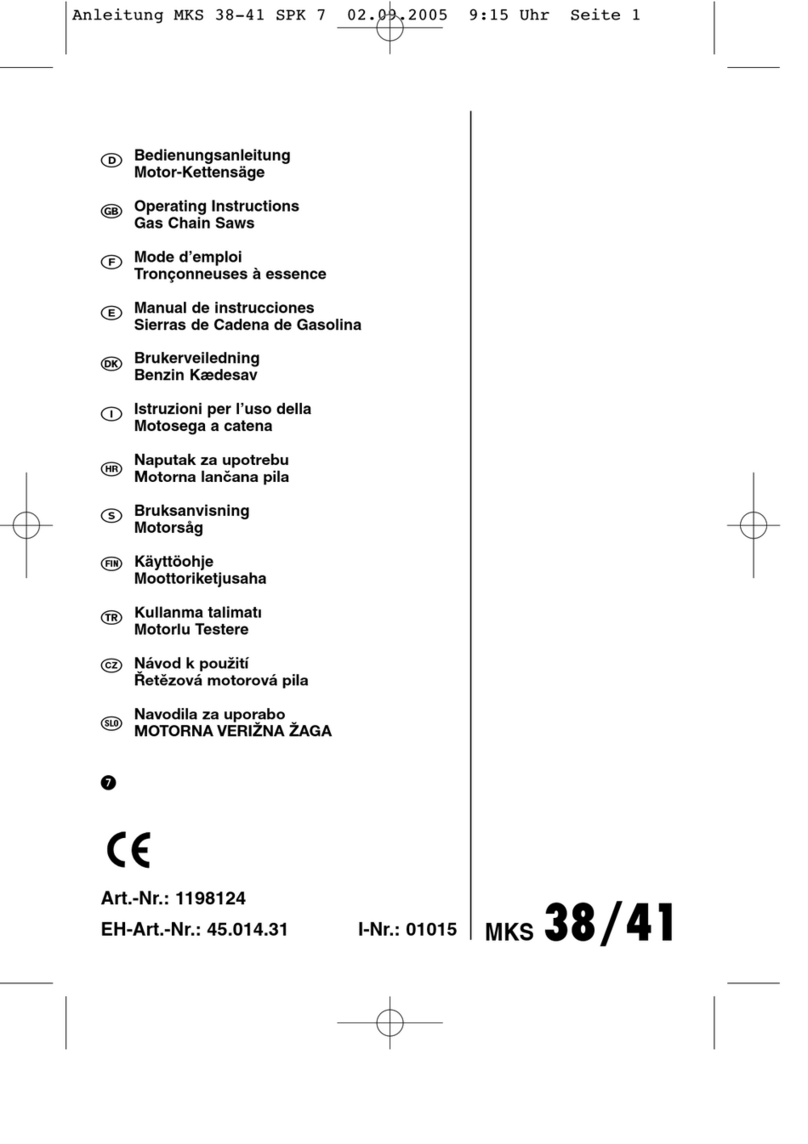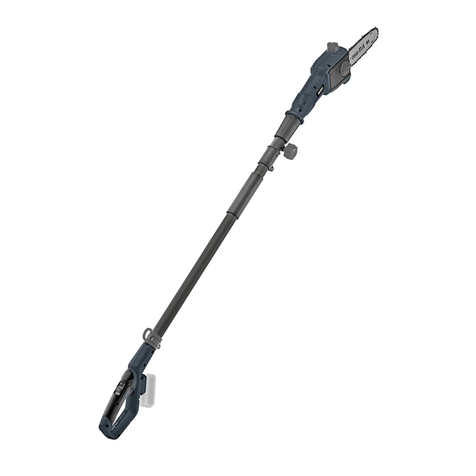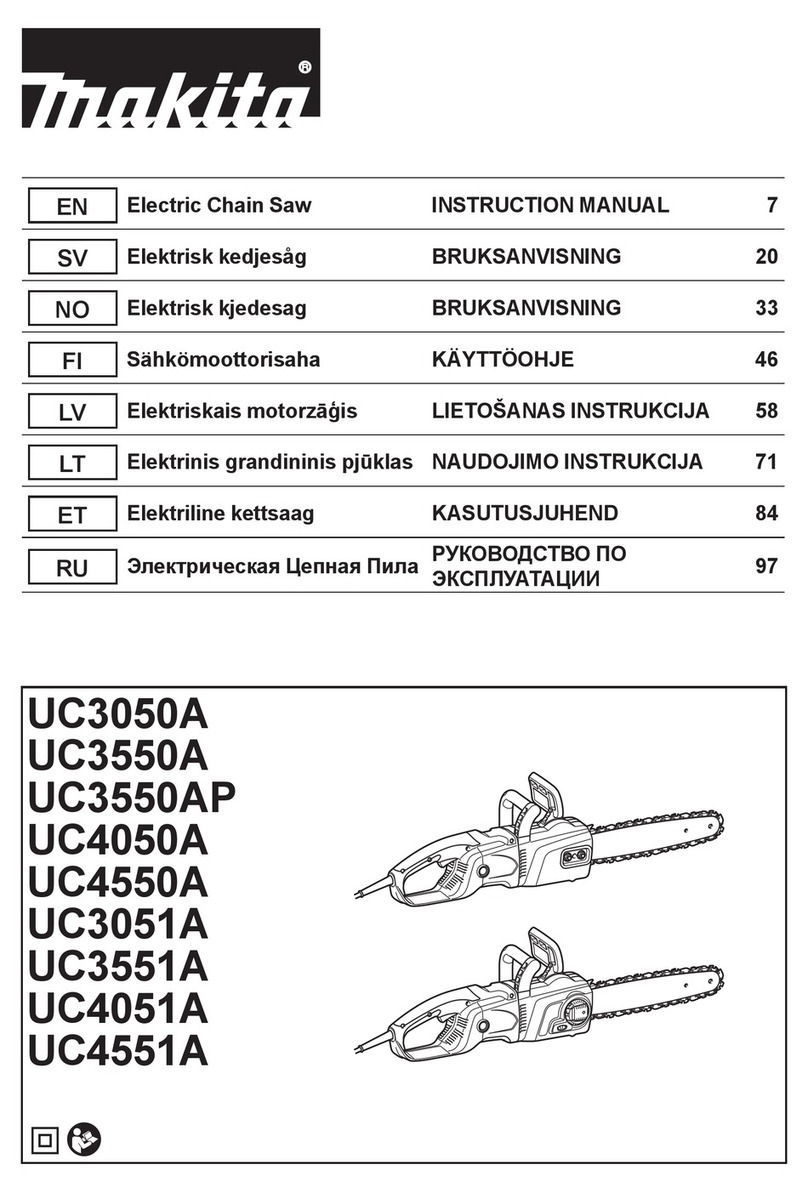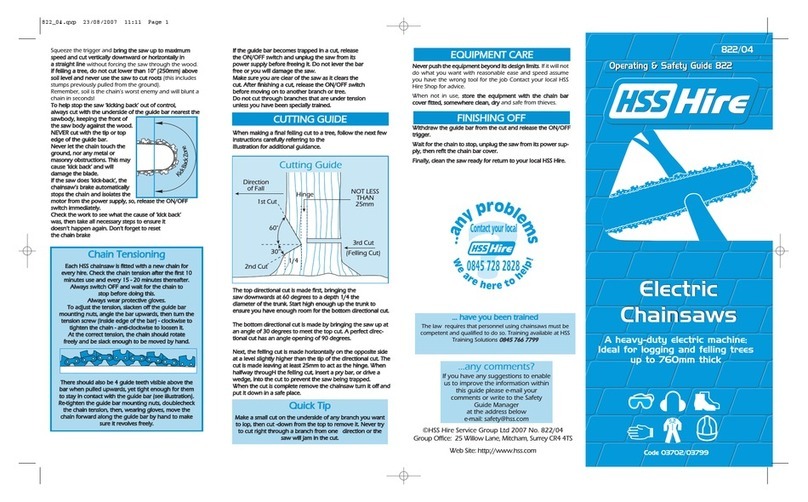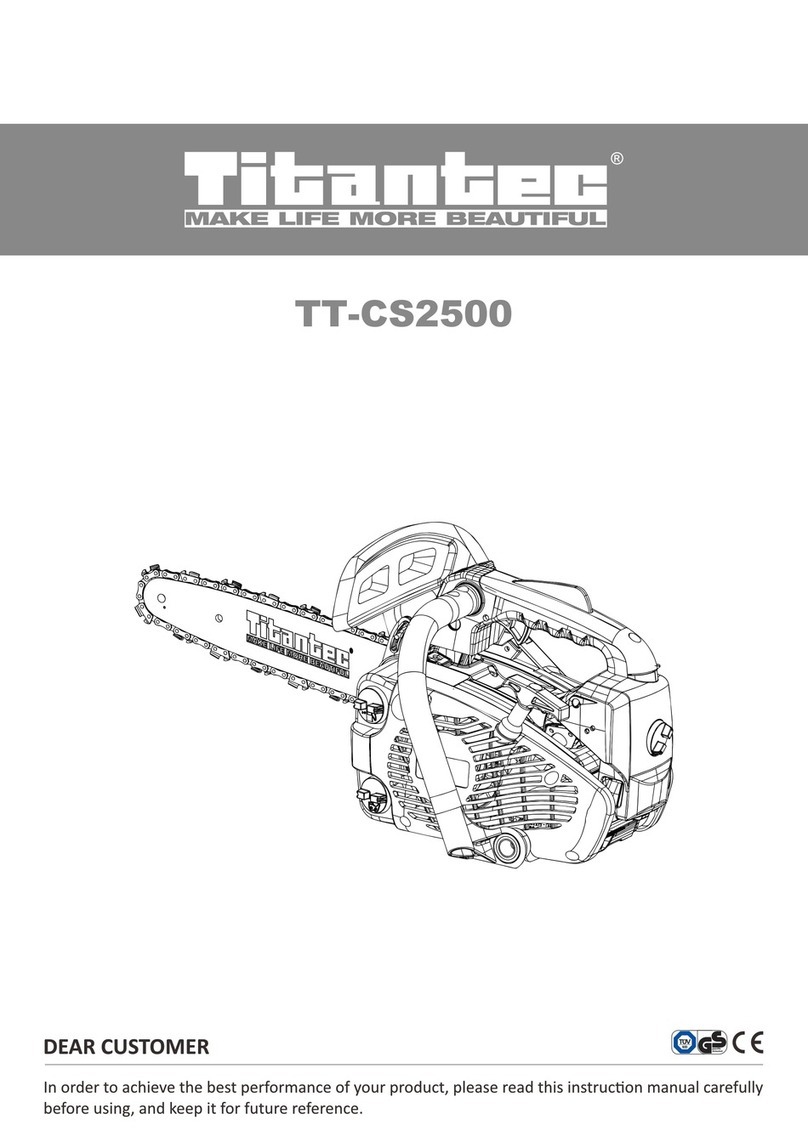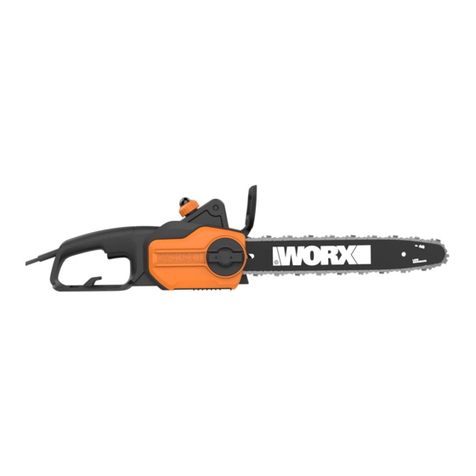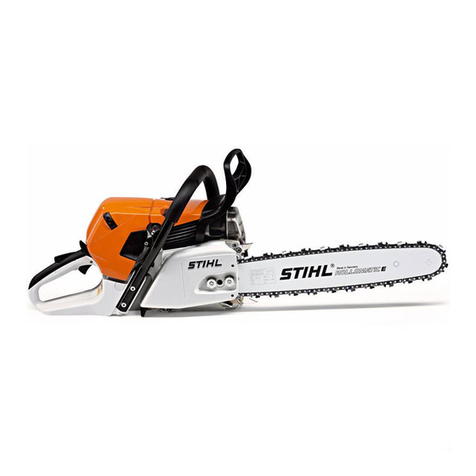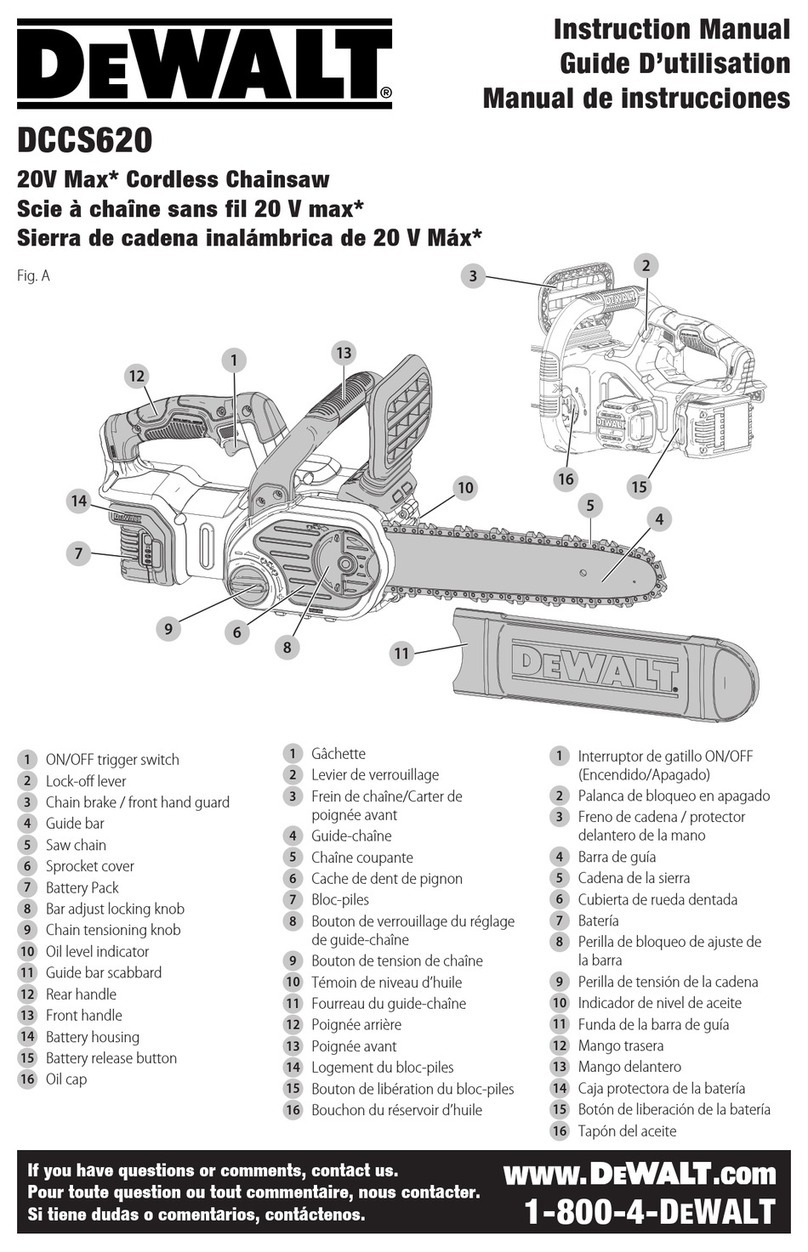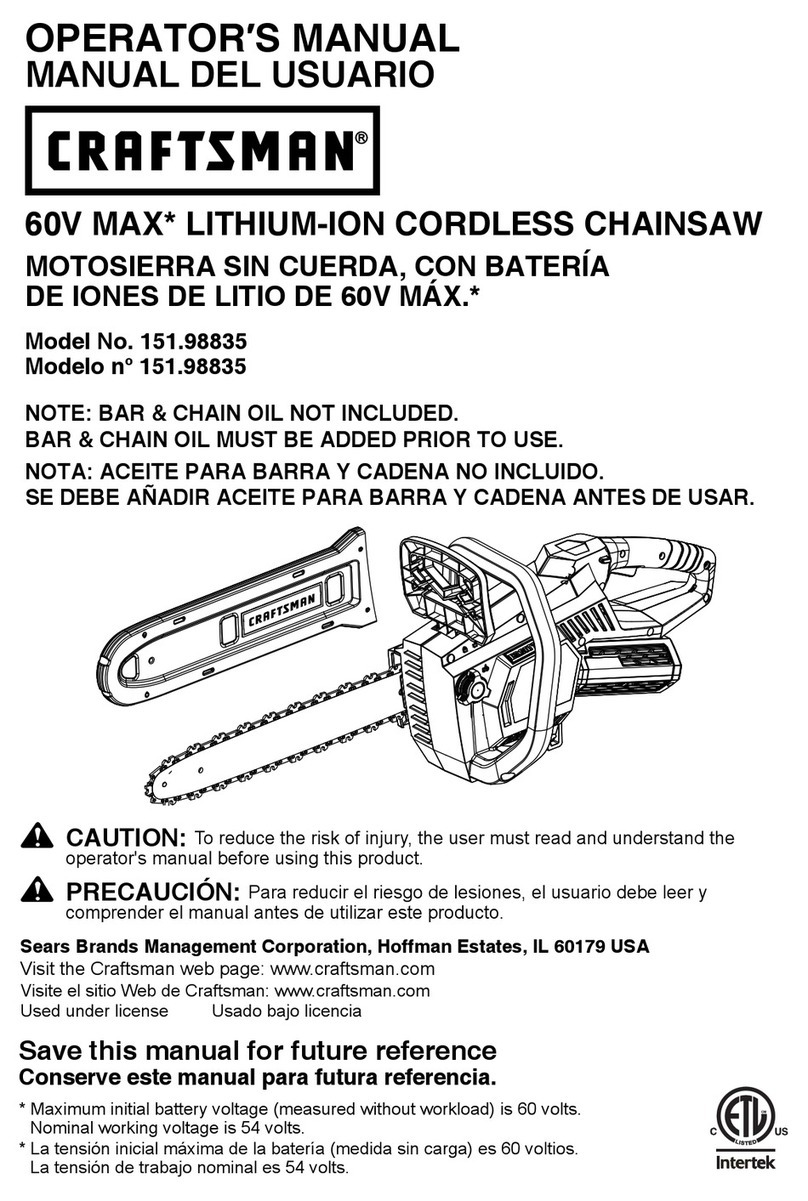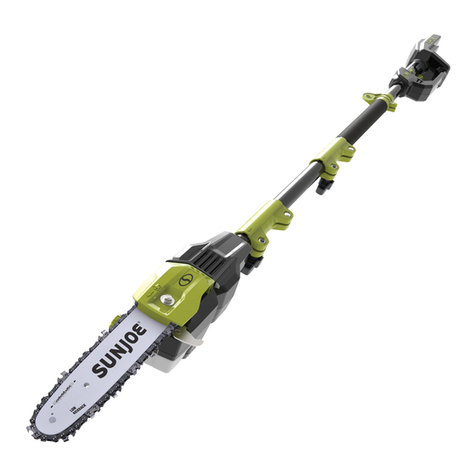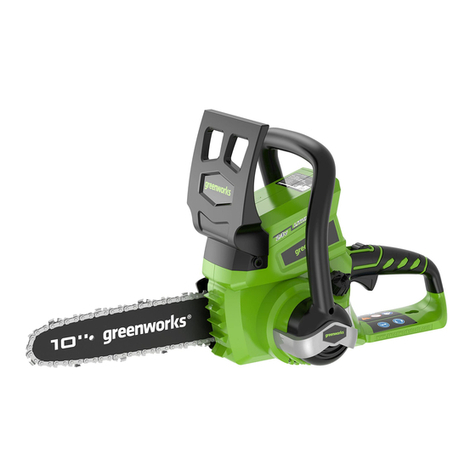Hyundai HYC40Li User manual

40V CHAINSAW
HYC40Li
Instruction Manual

Thank You For Purchasing Your HYUNDAI Product
We work very hard to give all of our customers the best possible service. If you have any
problems, before leaving negative feedback, please contact us to give us a chance to resolve
the issue. We would be delighted if you left us positive feedback! Thank you for purchasing this
product.
Important!
This manual has been produced by Hyundai Power Products and should be kept with the
product. Please read and understand these instructions before you use your product. Failure to
do this may result in personal injury or damage to the product.
The safety precautions and warnings are to ensure your safety and protect you from harm or
damage to the product.
The information contained in this manual was accurate at the time of production, however
HYUNDAI Power Products may make modifications to the product without notification.
!
WARNING : READ THE INSTRUCTION BOOKLET THOROUGHLY BEFORE
USING THE MACHINE. Keep for future reference and pass it on if the machine is
loaned or sold to another user.
Introduction

Contents
Safety Information....................4-12
Features........................................13
Machine Information....................14
Assembly and Operation........15-21
Maintenance and Storage......22-23
Troubleshooting...........................24
Disposal........................................25
Declaration of Conformity...........26
Notes........................................27-29
Useful Information........................30
Contact Us....................................31

This chain saw is only designed for cutting of brushes, trunks or timber beams up to a diameter according the guide bar length. It
is only allowed to cut wood. Every other use of the machine is a not intended use. Furthermore a professional use for tree
services is strictly forbidden.
During the use of the chain saw the user has to arrange for personal protective equipment according to the manual and also to
the named pictograms on the chain saw. Parts of the intended use are also the details in the manual regarding safety warnings
and references for use / maintenance. People/ User who work with the chain saw or make maintenances on it must be familiar
with the manual. It is only allowed to assemble on the chain saw the manufacturers original or approved spare parts (guide bar;
saw chain, spark plug e.g.) as well as the allowed combinations of guide bar / saw chain as named in the manual.
The user and not the manufacturer is liable for every accident which results from a combination of not intended use or a not
allowed change of the construction on the machine.
The chain saw is only intended to use outdoor.
Even with the intended use of the appliance there is always a residual risk, which can not prevented. According to the type and
construction of the appliance the following potential hazards might apply:
Contact with exposed saw teeth of the saw chain (cutting hazards)
Access to the rotating saw chain (cutting hazards)
Unforeseen, abrupt movement of the guide bar (cutting hazards)
Flung out of parts from the saw chain (Cutting / injection hazards)
Flung out of parts of the work piece
Inhalation of work peace particles, emissions from the gasoline engine
Skin contact with the fuel (gasoline / oil)
Loss of hearing, if no required ear protection used during work.
WARNING Read all safety warnings and all instructions. Failure to follow the warnings and instructions may result
in electric shock, fire and/or serious injury. Save all warnings and instructions for future reference.
The term "power tool" in the warnings refers to your mains-operated (corded) power tool or battery-operated (cordless)
power tool.
1) Work area safety
a) Keep work area clean and well lit. Cluttered or dark areas invite accidents.
b) Do not operate power tools in explosive atmospheres, such as in the presence of flammable liquids, gases or dust.
Power tools create sparks which may ignite the dust or fumes.
c) Keep children and bystanders away while operating a power tool. Distractions can cause you to lose control.
Safety Information
Intended Use
Residual Risks
General Power Tool Safety Warnings
4

2) Electrical safety
a) Power tool plugs must match the outlet. Never modify the plug in any way. Do not use any adapter plugs with earthed
(grounded) power tools. Unmodified plugs and matching outlets will reduce risk of electric shock.
b) Avoid body contact with earthed or grounded surfaces, such as pipes, radiators, ranges and refrigerators. There is an
increased risk of electric shock if your body is earthed or grounded.
c) Do not expose power tools to rain or wet conditions. Water entering a power tool will increase the risk of electric shock.
d) Do not abuse the cord. Never use the cord for carrying, pulling or unplugging the power tool. Keep cord away from heat,
oil, sharp edges or moving parts. Damaged or entangled cords increase the risk of electric shock.
e) When operating a power tool outdoors, use an extension cord suitable for outdoor use. Use of a cord suitable for
outdoor use reduces the risk of electric shock.
f) If operating a power tool in a damp location is unavoidable, use a residual current device (RCD) protected supply. Use of
an RCD reduces the risk of electric shock.
3) Personal safety
a) Stay alert, watch what you are doing and use common sense when operating a power tool. Do not use a power tool
while you are tired or under the influence of drugs, alcohol or medication. A moment of inattention while operating power
tools may result in serious personal injury.
b) Use personal protective equipment. Always wear eye protection. Protective equipment such as dust mask, non-skid
safety shoes, hard hat, or hearing protection used for appropriate conditions will reduce personal injuries.
c) Prevent unintentional starting. Ensure the switch is in the off-position before connecting to power source and/or battery
pack, picking up or carrying the tool. Carrying power tools with your finger on the switch or energising power tools that have
the switch on invites accidents.
d) Remove any adjusting key or wrench before turning the power tool on. A wrench or a key left attached to a rotating part
of the power tool may result in personal injury.
e) Do not overreach. Keep proper footing and balance at all times. This enables better control of the power tool in
unexpected situations.
f) Dress properly. Do not wear loose clothing or jewellery. Keep your hair, clothing and gloves away from moving parts.
Loose clothes, jewellery or long hair can be caught in moving parts.
g) If devices are provided for the connection of dust extraction and collection facilities, ensure these are connected and
properly used. Use of dust collection can reduce dust-related hazards.
4) Power tool use and care
a) Do not force the power tool. Use the correct power tool for your application. The correct power tool will do the job better
and safer at the rate for which it was designed.
b) Do not use the power tool if the switch does not turn it on and off. Any power tool that cannot be controlled with the
switch is dangerous and must be repaired.
c) Disconnect the plug from the power source and/or the battery pack from the power tool before making any adjustments,
changing accessories, or storing power tools. Such preventive safety measures reduce the risk of starting the power tool
accidentally.
d) Store idle power tools out of the reach of children and do not allow persons unfamiliar with the power tool or these
instructions to operate the power tool. Power tools are dangerous in the hands of untrained users.
e) Maintain power tools. Check for misalignment or binding of moving parts, breakage of parts and any other condition that
may affect the power tool’s operation. If damaged, have the power tool repaired before use. Many accidents are caused by
Safety Information (Continued)
5

poorly maintained power tools.
f) Keep cutting tools sharp and clean. Properly maintained cutting tools with sharp cutting edges are less likely to bind and
are easier to control.
g) Use the power tool, accessories and tool bits etc. in accordance with these instructions, taking into account the working
conditions and the work to be performed. Use of the power tool for operations different from those intended could result in a
hazardous situation.
5) Battery tool use and care
a) Recharge only with the charger specified by the manufacturer. A charger that is suitable for one type of battery pack may
create a risk of fire when used with another battery pack.
b) Use power tools only with specifically designated battery packs. Use of any other battery packs may create a risk of injury
and fire.
c) When battery pack is not in use, keep it away from other metal objects, like paper clips, coins, keys, nails, screws or other
small metal objects, that can make a connection from one terminal to another. Shorting the battery terminals together may
cause burns or a fire.
d) Under abusive conditions, liquid may be ejected from the battery; avoid contact. If contact accidentally occurs, flush with
water. If liquid contacts eyes, additionally seek medical help. Liquid ejected from the battery may cause irritation or burns.
6) Service
a) Have your power tool serviced by a qualified repair person using only identical replacement parts. This will ensure that the
safety of the power tool is maintained.
a) Do not dismantle, open or shred cells or battery pack.
b) Do not short-circuit a battery pack. Do not store battery packs haphazardly in a box or drawer where they may short-circuit
each other or be short-circuited by conductive materials. When battery pack is not in use, keep it away from other metal
objects, like paper clips, coins, keys, nails, screws or other small metal objects, that can make a connection from one
terminal to another. Shorting the battery terminals together may cause burns or a fire.
c) Do not expose battery pack to heat or fire. Avoid storage in direct sunlight.
d) Do not subject battery pack to mechanical shock.
e) In the event of battery leaking, do not allow the liquid to come into contact with the skin or eyes. If contact has been made,
wash the affected area with copious amounts of water and seek medical advice.
f) Seek medical advice immediately if a cell or battery pack has been swallowed.
g) Keep battery pack clean and dry.
h) Wipe the battery pack terminals with a clean dry cloth if they become dirty.
i) Battery pack needs to be charged before use. Always refer to this instruction and use the correct charging procedure.
j) Do not maintain battery pack on charge when not in use.
k) After extended periods of storage, it may be necessary to charge and discharge the battery pack several times to obtain
maximum performance.
l) Battery pack gives its best performance when it is operated at normal room temperature (20 °C ± 5 °C).
m) When disposing of battery packs, keep battery packs of different electrochemical systems separate from each other.
n) Recharge only with the charger specified by REDBACK. Do not use any charger other than that specifically provided for use
with the equipment. A charger that is suitable for one type of battery pack may create a risk of fire when used with another
Safety Information (Continued)
battery pack.
Battery Pack Safety Warnings
6

o) Do not use any battery pack which is not designed for use with the equipment.
p) Keep battery pack out of the reach of children.
q) Retain the original product literature for future reference.
r) Remove the battery from the equipment when not in use.
s) Dispose of properly.
t) Use a charger approved according to EN 60335-2-29
1. Before using your cordless chain saw
Your Battery Pack is UNCHARGED and it must be fully charged once before it is used.
The battery charger supplied is matched to the Li-ion battery for use with this tool. Do not use another battery
charger.
2. Charging your Battery Pack
The Li-ion battery is protected against over discharging. When the battery is empty, the trimmer will switch off
by means of a protective circuit: The trimmer head will stop rotating.
Note: In a warm environment or after heavy use, the Battery Pack may become too hot to permit charging.
Allow time for the battery to cool down before recharging.
3. Storage of the charger and battery
For long-term storage, it is preferable that the battery is fully charged and stored in a dry place at a
temperature between 10 and 25 ° C.
The charger should be stored in the same conditions as the battery, taking care that no foreign objects such as
metal chips or other can not enter through the ventilation slots of the charger.
1. Keep all parts of the body away from the saw chain when the chain saw is operating. Before you start the chain saw, make
sure the saw chain is not contacting anything. A moment of inattention while operating chain saws may cause entanglement
of your clothing or body with the saw chain.
2. Always hold the chain saw with your right hand on the rear handle and your left hand on the front handle. Holding the chain
saw with a reversed hand configuration increases the risk of personal injury and should never be done.
3. Hold the power tool by insulated gripping surfaces only, because the saw chain may contact hidden wiring. Saw chains
contacting a live wire may make exposed metal parts of the power tool live and could give the operator an electric shock.
4. Wear safety glasses and hearing protection. Further protective equipment for head, hands, legs and feet is recommended.
Adequate protective clothing will reduce personal injury by flying debris or accidental contact with the saw chain.
5. Do not operate a chain saw in a tree. Operation of a chain saw while up in a tree may result in personal injury.
6. Always keep proper footing and operate the chain saw only when standing on fixed, secure and level surface. Slippery or
unstable surfaces such as ladders may cause a loss of balance or control of the chain saw.
7. When cutting a limb that is under tension be alert for spring back. When the tension in the wood fibres is released the spring
loaded limb may strike the operator and/or throw the chain saw out of control.
8. Use extreme caution when cutting brush and saplings. The slender material may catch the saw chain and be whipped
toward you or pull you off balance.
9. Carry the chain saw by the front handle with the chain saw switched off and away from your body. When transporting or
Safety Information (Continued)
Instruction Before Use
7
Chainsaw Safety

storing the chain saw always fit the guide bar cover. Proper handling of the chain saw will reduce the likelihood of accidental
contact with the moving saw chain.
10. Follow instructions for lubricating, chain tensioning and changing accessories. Improperly tensioned or lubricated chain may
either break or increase the chance for kickback.
11. Keep handles dry, clean, and free from oil and grease. Greasy, oily handles are slippery causing loss of control.
12. Cut wood only. Do not use chain saw for purposes not intended. For example: do not use chain saw for cutting plastic,
masonry or non-wood building materials. Use of the chain saw for operations different than intended could result in a
hazardous situation.
Kickback may occur when the nose or tip of the guide bar touches an object, or when the wood closes in and pinches the saw
chain in the cut.
Tip contact in some cases may cause a sudden reverse reaction, kicking the guide bar up and back towards the operator.
Pinching the saw chain along the top of the guide bar may push the guide bar rapidly back towards the operator.
Either of these reactions may cause you to lose control of the saw which could result in serious personal injury. Do not rely
exclusively upon the safety devices built into your saw. As a chain saw user, you should take several steps to keep your cutting
jobs free from accident or injury.
Kickback is the result of tool misuse and/or incorrect operating procedures or conditions and can be avoided by taking proper
precautions as given below:
1 . Maintain a firm grip, with thumbs and fingers encircling the chain saw handles, with both hands on the saw and position your
body and arm to allow you to resist kickback forces. Kickback forces can be controlled by the operator, if proper precautions are
taken. Do not let go of the chain saw.
2. Do not overreach and do not cut above shoulder height. This helps prevent unintended tip contact and enables better control of
the chain saw in unexpected situations.
3. Only use replacement bars and chains specified by the manufacturer. Incorrect replacement bars and chains may cause chain
breakage and/or kickback.
4. Follow the manufacturer’s sharpening and maintenance instructions for the saw chain. Decreasing the depth gauge height can
lead to increased kickback.
Safety Information (Continued)
Causes and Operator Prevention of Kickback
8

Before felling is started, consider the natural lean of the tree, the location of larger branches and the wind direction
to judge which way the tree will fall.
Remove dirt, stones, loose bark, nails, staples and wire from the tree..
Figure 3Figure 4
2. Notching Undercut
Make the notch 1/3 the diameter of the tree, perpendicular to the direction of fall as illustrated in Figure 4. Make the
lower horizontal notching cut first. This will help to avoid pinching of either the saw chain or the guide bar when the
second notch is being made.
3. Felling Back Cut
Make the felling back cut at least 2 inches (50.8 mm) higher thanthe horizontal notching cut as illustrated in Figure 4.
Keep the felling back cut parallel to the horizontal notching cut. Make the felling back cut so enough wood is left to
act as a hinge. The hinge wood keeps the tree from twisting and falling in the wrong direction. Do not cut through the
hinge. As the felling cut gets close to the hinge the tree should begin to fall. If there is any chance that the tree may
not fall in the desired direction or it may rock back and bind the saw chain, stop cutting before the felling back cut is
complete and use wedges of wood, plastic or aluminum to open the cut and drop the tree along the desired line of
fall.
When the tree begins to fall remove the chain saw from the cut, stop the motor, put the chain saw down, then use
the retreat path planned. Be alert for overhead limbs falling and watch your footing.
Safety Information (Continued)
9
1. Felling a tree
When bucking and felling operations are being performed by two or more persons at the same time, the felling
operations should be separated from the bucking operation by a distance of at least twice the height of the tree
being felled. Trees should not be felled in a manner that would endanger any person, strike any utility line or cause
any property damage. If the tree does make contact with any utility line, the company should be notified
immediately.
The chain saw operator should keep on the uphill side of the terrain as the tree is likely to roll or slide downhill after it
is felled.
An escape path should be planned and cleared as necessary before cuts are started. The escape path should
extend back and diagonally to the rear of the expected line of fall as illustrated in Figure 3.

Safety Information (Continued)
10
Figure 5
4. Limbing a Tree
Limbing is removing the branches from a fallen tree. When limbing, leave larger lower limbs to support the log off
the ground. Remove the small limbs in one cut as illustrated in Figure 5. Branches under tension should be cut from
the bottom up to avoid binding the chain saw.

Figure 6 Figure 7
Figure 8Figure 9
Safety Information (Continued)
5. Bucking a Log
Bucking is cutting a log into lengths. It is important to make sure your footing is firm and your weight is evenly
distributed on both feet. When possible, the log should be raised and supported by the use of limbs, logs or chocks.
Follow the simple directions for easy cutting.
When the log is supported along its entire length as illustrated in Figure 6, it is cut from the top (overbuck).
When the log is supported on one end, as illustrated in Figure 7, cut 1/3 the diameter from the underside
(underbuck). Then make the finished cut by over bucking to meet the first cut. When the log is supported on both
ends, as illustrated in Figure 8, cut 1/3 of that diameter from the top over buck. Then make the finished cut by
underbucking the lower 2/3 to meet the first cut. When bucking on a slope always stand on the uphill side of the log,
as illustrated in Figure 9. When “cutting through”, to maintain complete control release the cutting pressure near the
end of the cut without relaxing your grip on the chain saw handles. Don’t let the chain contact the ground. After
completing the cut, wait for the saw chain to stop before you move the chain saw. Always stop the motor before
moving from tree to tree.
11

Do not burn the battery
Do not expose to rain or water
Hold the chain saw by two hands
Danger of Kickback: never cut with the tip of the chainsaw
This product has been marked with a symbol relating to removing electric and electronic waste. This
means that this product shall not be discarded with household waste but that it shall be returned to a
collection system which conforms to the European Directive 2002/96/CE. It will then be recycled or
dismantled in order to reduce the impact on the environment. Electric and electronic equipment can be
hazardous for the environment and for human health since they contain hazardous substances.
Do not dispose of batteries. Return exhausted batteries to your local collection or recycling point.
Safety Information (Continued)
To reduce the risk of injury, user must read instruction manual
Warning
Wear dust mask
Wear ear protection
Do not expose to moisture
Wear eye protection
Symbols On The Machine
12

Features
1.Chain bar
2.Chain
3.Chain tensioning knob
4.Locking knob
5.Cover plate
6.Oil filler cap
7.Rear handle
8. Hand guard
9. Spiked bumper
10. Battery pack
11. Lock off button
12. On/off switch
13. Blade cover
13

PACKAGE CONTENTS
Chainsaw body
Chain guide bar
Saw chain
Operator’s manual
We recommend that you purchase your accessories from the same store that sold you the tool. Use good quality accessories
marked with a well-known brand name. Choose the type according to the work you intend to undertake. Refer to the accessory
packaging for further details. Store personnel can assist you and offer advice.
Model HYC40Li
Voltage 40V DC
Battery pack HYBAT40Li25
Chain speed 17m/s
Oil tank capacity 180ml
Guide bar length 14”/355mm
Noise Information (determined according to ISO 22868, EN 3744)
A weighted sound pressure LpA: 89 dB (A), KpA = 3 dB (A)
A weighted sound power LwA.d: 103 dB (A)
Vibration Information (determined according to ISO 22867):
Vibration emission value: ah= 3.5 m/s2Uncertainty K = 1.5 m/s²
WARNING: national laws can limit the use of the tool refer to noise emission.
The declared vibration total value may be used for comparing one tool with another, and may also be used in a
preliminary assessment of exposure.
WARNING: The vibration emission value during actual use of the power tool can differ from the declared value depending
on the ways in which the tool is used dependant on the following examples and other variations on how the tool is used:
How the tool is used and the materials are cut or drilled.
The tool being in good condition and well maintained
The use the correct accessory for the tool and ensuring it is sharp and in good condition.
The tightness of the grip on the handles and any anti vibration accessories are used.
And the tool is being used as intended by its design and these instructions.
This tool may cause hand-arm vibration syndrome if its use is not adequately managed. Hands may become dull and
numbing.
WARNING: To be accurate, an estimation of exposure level in the actual conditions of use should also take account of all
parts of the operating cycle such as the times when the tool is switched off and when it is running idle but not actually doing
the job. This may significantly reduce the exposure level over the total working period.
Help to minimize your vibration exposure risk.
ALWAYS use sharp chisels, drills and blades.
Machine Information
Maintain this tool in accordance with these instructions and keep well lubricated (where appropriate).
If the tool is to be used regularly then invest in anti vibration accessories.
Avoid using tools in temperatures of 100C or less.
Plan your work schedule to spread any high vibration tool use across a number of days.
Package Contents
Specification
14

WARNING! Do not connect the chain saw to mains before it is completely assembled. Always
use gloves when handling the chain.
The chain must be so fitted over the guide bar that the cutting edges of the cutters (a) face in the direction that the
chain runs.
Hold the guide bar with the nose upwards and place the saw chain so on sprocket of the guide bar engage into
the chain links and the bottom sections of the drive links are situated in the groove of the bar. The chain is
correctly tensioned when it is still possible to raise it by 2-4 mm. The direction of rotation of the saw chain is
indicated by two arrows on the drive-sprocket cover.
Assembly and Operation
Assembly / Replacement of the Guide Bar and Chain
15

Chain and chain bar assembly:
Put the battery pack(10) as shown above, taking care to press any button to prevent accidental Starting.
Assembly and Operation
- Unpack all parts carefully.
- Place the chain saw on any suitable flat surface with the motor facing downwards.
- Fit the chain onto the drive sprocket and guide the chain bar. So that the fastening bolt lit into the keyway of the
chain bar. Check if all parts are seated properly and hold chain and chain bar in a level position.
- Fit cover. Check that arrows are still aligned
- Use the chain tension knob to get the correct tension in the chain. Finally tighten the sprocket cover knob.
Battery Pack Assembly
Chain and Chain Bar Assembly
16

1. Push brake baffle (A) to Startup
2: You will heard sound of beep from the switch(B). The light will be green when everything is ok and flicker if
with some problems.
3: Press the lock switch (C) and open the switch wrench.
LUBRICATION
Important: the chain saw is not supplied filled with oil. It is essential to fill with oil before use.
Never operate the chain saw without chain oil or at an empty oil tank level, as this will result in
extensive damage to the product.
Chain life and cutting capacity depend on optimum lubrication. Therefore, the chain is automatically oiled during
operation via oil outlet.
Filling oil tank:
1. Set chain saw on any suitable surface with oil filler cap facing upward.
2. Clean area around the oil filler cap with cloth unscrew cap.
3. Do not remove filter insert during filling.
4. Add chain saw oil until reservoir is full.
5. Avoid dirt or debris entering oil tank, refit oil filler cap (4) and tighten.
Important: To allow venting of the oil reservoir, small breather channels are provided between
the oil filler cap and the strainer, to prevent leakage ensure machine is left in a horizontal
position (oil filler cap (4) uppermost) when not in use.
Assembly and Operation (Continued)
Starting
Lubrication
17
It is important to use only the recommended oil to avoid damage to the chain saw. Never use recycled/old oil. Use
of non approved oil will invalidate the warranty.

LUBRICATION
Important: the chain saw is not supplied filled with oil. It is essential to fill with oil before use.
Never operate the chain saw without chain oil or at an empty oil tank level, as this will result in
extensive damage to the product.
Chain life and cutting capacity depend on optimum lubrication. Therefore, the chain is automatically oiled during
operation via oil outlet.
Filling oil tank:
1. Set chain saw on any suitable surface with oil filler cap facing upward.
2. Clean area around the oil filler cap with cloth unscrew cap.
3. Do not remove filter insert during filling.
4. Add chain saw oil until reservoir is full.
5. Avoid dirt or debris entering oil tank, refit oil filler cap (4) and tighten.
Important: To allow venting of the oil reservoir, small breather channels are provided between
the oil filler cap and the strainer, to prevent leakage ensure machine is left in a horizontal
position (oil filler cap (4) uppermost) when not in use.
Assembly and Operation (Continued)
Lubrication
It is important to use only the recommended oil to avoid damage to the chain saw. Never use recycled/old oil. Use
of non approved oil will invalidate the warranty.
18

1.Switching on and off (See fig. A)
Check the voltage and current supply: The voltage and current supply must comply with the ratings on the type
plate.
For switching on the machine, press the lock-off button(3), then fully press the on/off switch(2) and hold in this
position. The lock-off button(3) can now be released. For switching off, release the on/off switch(2).
2.Fill the Oil Reservoir (See fig. B)
Check oil level gauge (19) prior to starting and regularly during operation. Refill oil when oil level is low. The oil
tank filling will last approx. 16minutes, depending on sawing intensity and stops. (Fig. B) Check new replaced
chain tension approx. every 10 minutes during operation.
B
Assembly and Operation (Continued)
Starting
19

Assembly and Operation (Continued)
20
The unit has an LED state of charge indicator on the handlebar.
4 LED lights lit = 100% battery power
3 LED lights lit = 75% battery power
2 LED lights lit = 50% battery power
1 LED light lit = 25% battery power
Charging The Battery
1. Plug the charger into an AC outlet 220-250V (normal household voltage).
2. Insert the battery into the slots of the charger and slide into place until the battery locks
into place.
3. The LED will flash green while the battery is charging.
4. Once the battery is fully charged, the LED indicator will show a steady green light.
5. Remove the battery by pressing and holding the latch button and sliding out of the
charger.
6. Do not leave the battery on the charger. Remove it when it is fully charged.
7. Lithium-ion batteries have no memory effect - a partial charge will not damage your
battery.
WARNING! Charge in a safe location away from moisture and heat sources!
Checking Charge Status
Table of contents
Other Hyundai Chainsaw manuals
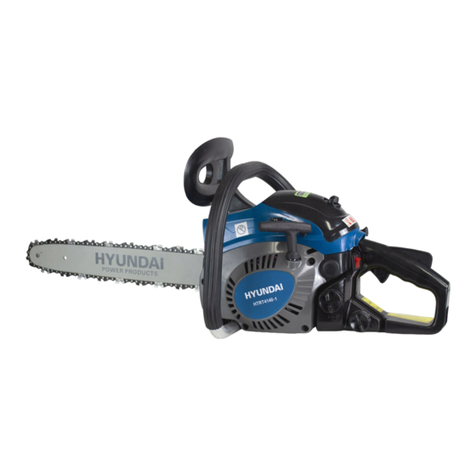
Hyundai
Hyundai HTRT4140-1 User manual

Hyundai
Hyundai HTRT45H45-1 User manual
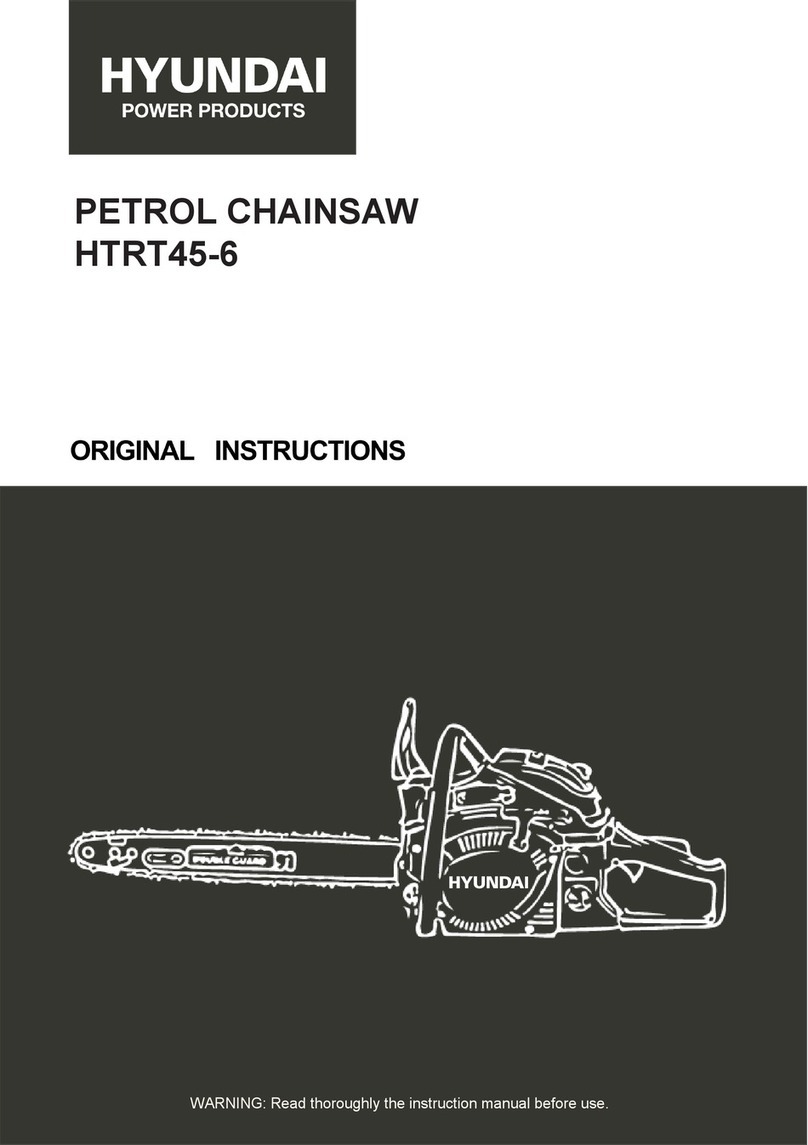
Hyundai
Hyundai HTRT45-6 User manual
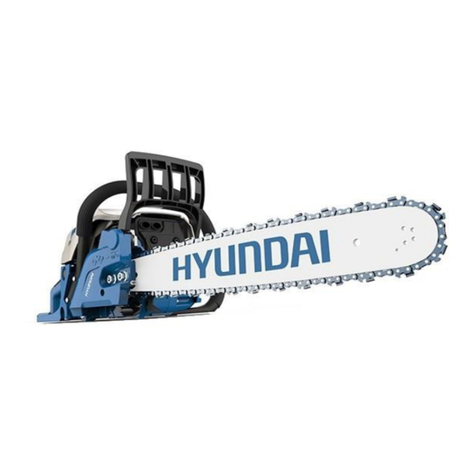
Hyundai
Hyundai HYC6220 User manual

Hyundai
Hyundai HY6222 User manual
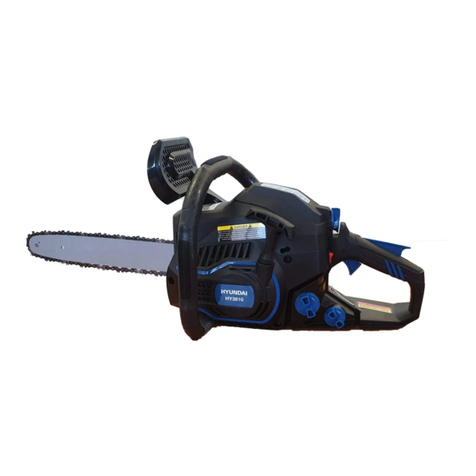
Hyundai
Hyundai HY3810 User manual
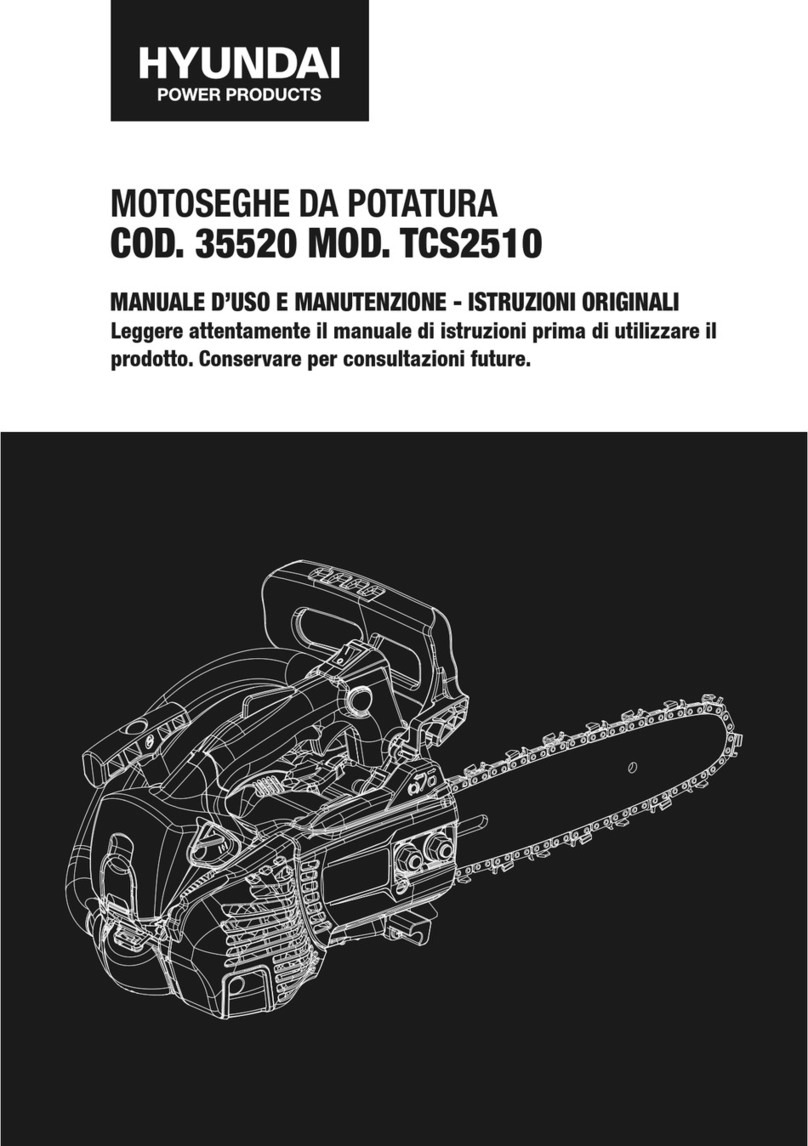
Hyundai
Hyundai TCS2510 User manual
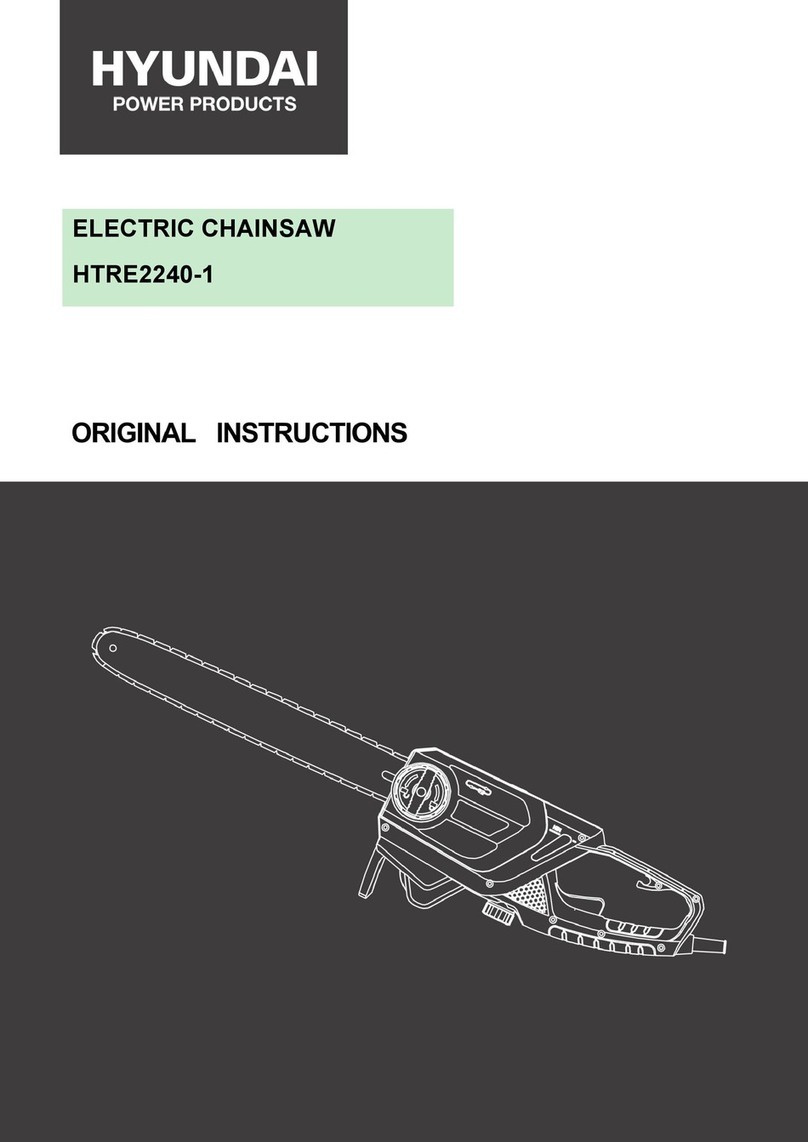
Hyundai
Hyundai HTRE2240-1 User manual

Hyundai
Hyundai HYC3816 User manual

Hyundai
Hyundai HYC6200X User manual

